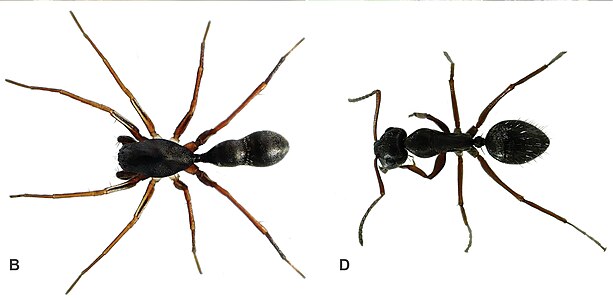Camponotus planatus
| Camponotus planatus | |
|---|---|

| |
| Scientific classification | |
| Domain: | Eukaryota |
| Kingdom: | Animalia |
| Phylum: | Arthropoda |
| Class: | Insecta |
| Order: | Hymenoptera |
| Family: | Formicidae |
| Subfamily: | Formicinae |
| Genus: | Camponotus |
| Species: | C. planatus
|
| Binomial name | |
| Camponotus planatus Roger, 1863
| |
Camponotus planatus, known generally as the compact carpenter ant or short carpenter ant, is one of three Camponotus species that is polygynous, or has more than one queen. It is a species of ant (family Formicidae).[1][2][3][4][5][6][7][8]
This article may contain an excessive number of citations. (February 2024) |
Arthropod mimics[edit]
Four species of arthropod mimic Camponotus planatus within the Mountain Pine Ridge Forest Reserve of British Honduras.[9] This is both Batesian and Wassmanian mimicry.[9] The first mimic is the clubnoid spider (Myrmecotypus fuliginosus) which mimics C. planatus in various ways including morphology and behaviour. Secondly, the salticid spider Sarindia linda mimics C. planatus so well that they are hard to distinguish. S. linda mimics the locomotion patterns, pumping of the abdomen, and movements of the antennae.[9] The third mimic is a Mirid bug (Barberiella) which mimics the model in both gait and antennal mimicry. Finally, the mantid, Mantoida maya also uses C. planatus as a model.[9] Individuals that mimic C. planatus are typically 3-9mm long and predators tend to avoid them. All four mimics have been seen foraging in areas with their model with no interference.[10]
-
Myrmecotypus mazaxoides mimic (left), carpenter ant model (right)
Subspecies[edit]
- Camponotus planatus acaciae Emery, 1920
- Camponotus planatus colombicus Forel, 1899
- Camponotus planatus continentis Forel, 1901
- Camponotus planatus esdras Forel, 1916
- Camponotus planatus planatus Roger, 1863
References[edit]
- ^ "Camponotus planatus Species Information". BugGuide.net. Retrieved 2018-02-03.
- ^ "Camponotus planatus Report". Integrated Taxonomic Information System. Retrieved 2018-02-03.
- ^ Sharkey M.J. (2007). Phylogeny and Classification of Hymenoptera.
- ^ "Phylogenetic relationships among superfamilies of Hymenoptera", Sharkey M.J., Carpenter J.M., Vilhelmsen L., et al. 2012. Cladistics 28(1): 80-112.
- ^ Ward, P.S. (2007). "Phylogeny, classification, and species-level taxonomy of ants". Zootaxa 1668 549–563
- ^ "AntWeb". antweb.org. California Academy of Sciences. Retrieved 2018-02-03.
- ^ Bolton, B., Alpert, G., Ward, S. Naskrecki, P. (2007). A New General Catalogue of the Ants of the World 1758–2005
- ^ Riley, Edward G., Clark, Shawn M., and Gilbert, Arthur J. (2001). "New records, nomenclatural changes, and taxonomic notes for select North American leaf beetles". Insecta Mundi. 176.
- ^ a b c d Jackson, James F.; Drummond, Boyce A. (1974). "A Batesian Ant-Mimicry Complex from the Mountain Pine Ridge of British Honduras, with an Example of Transformational Mimicry". The American Midland Naturalist. 91 (1): 248–251. doi:10.2307/2424528. JSTOR 2424528.
- ^ Oliveira, Paulo S.; Sazime, Ivan (June 1984). "The adaptive bases of ant-mimicry in a neotropical aphantochilid spider (Araneae: Aphantochilidae)". Biological Journal of the Linnean Society. 22 (2): 145–155. doi:10.1111/j.1095-8312.1984.tb01675.x.
- Hansson C, Lachaud J, Pérez-Lachaud G (2011). "Entedoninae wasps (Hymenoptera, Chalcidoidea, Eulophidae) associated with ants (Hymenoptera, Formicidae) in tropical America, with new species and notes on their biology". ZooKeys 134: 62–82.
Further reading[edit]
- Arnett, Ross H. (2000). American Insects: A Handbook of the Insects of America North of Mexico. CRC Press.

